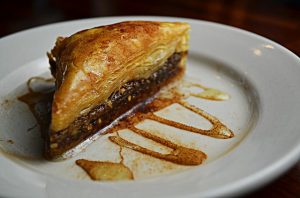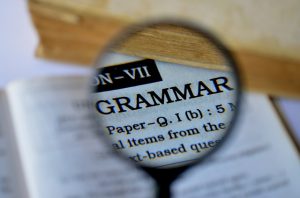
What’s the difference between “which” and “that”? When is it correct to use one or the other? What kinds of questions will you see about them on the GMAT? These are all great questions. The good news: that vs. which GMAT sentence correction questions aren’t as tough as they appear—even if you’re not a native English speaker.
In this post, we’ll give you all the rules you need to know about which vs. that GMAT questions, an in-depth breakdown of all the kinds of sentence correction questions that test this concept, and some tips for easily distinguishing between the two pronouns (even in long, complex sentence constructions)! By the time we’re done, you’ll be able to nail any that vs. which GMAT question that comes your way.
What Do “That” and “Which” Mean? Why Are They Confusing?
“That” and “which”—along with “who,” “whose,” and “whom”—are in the group of words called relative pronouns. Relative pronouns are found at the beginning of a relative clause. Relative clauses function the same way adjective clauses do: they are used to define, identify, or give extra information about the noun that precedes them.
Here’s an example of a sentence with a relative clause:
Correct: Baklava, which many people love, can be tricky to make.
Not sure how or what to study? Confused by how to improve your score in the shortest time possible? We've created the only Online GMAT Prep Program that identifies your strengths and weaknesses, customizes a study plan, coaches you through lessons and quizzes, and adapts your study plan as you improve.
We believe PrepScholar GMAT is the best GMAT prep program available, especially if you find it hard to organize your study schedule and don't want to spend a ton of money on the other companies' one-size-fits-all study plans.

Here, “which” is the relative pronoun standing in for “baklava.” This sentence is correct as written, but many of you might be wondering: Why can’t it be written with “that?”
Incorrect: Baklava, that many people love, can be tricky to make.
And why does it need commas?
Incorrect: Baklava which many people love can be tricky to make.
Incorrect: Baklava that many people love can be tricky to make.
Relative clauses are a category of grammar that the GMAT loves to test you on; fortunately, the two rules below will clarify how to pick correctly between “that” vs. “which” every time.
-

Could somebody please make some baklava for me?!
Rule #1: That vs. Which = Restrictive vs. Nonrestrictive
Consider the following two examples:
Correct: The apples, which were on the counter, went bad. The strawberries, which were in the refrigerator, stayed fresh.
Also correct: The apples that were on the counter went bad, but the apples that were in the freezer stayed edible for months.
In the first example, the relative clause “which were on the counter” isn’t necessary to specify which apples you’re talking about. The subject of the sentence is clear and defined without the additional information. The reader can assume you mean all the apples present, and the same goes for the strawberries.
However, in the second example, the relative clause “that were on the counter” is necessary to specify which apples you’re talking about. Of all the apples, specifically the ones that were on the counter went bad. If you got rid of the “that” clause, the subject would be unclear—so the clause is essential to the meaning of the sentence. It’s not “by the way” information, like the “which” clauses in the first example are.
In official terms, the first example contains nonrestrictive or nonessential relative clauses, and the second example contains a restrictive or essential relative clause.
Restrictive clauses contain information that is necessary for identifying or specifying the nouns they modify. They begin with “that” (or “who,” if you’re referring to a person).
Nonrestrictive clauses contain information that is additional—it may be important stuff to know, but the nouns they’re modifying are clear and defined, even if you got rid of the clause. They begin with “which” (or “who,” if you’re referring to a person).
-

Don’t let these delicious apples go bad!
Rule #2: Nonrestrictive Clauses Get Commas, Restrictive Clauses Don’t
Nonrestrictive clauses are “set off” by commas: one always comes before the clause, and one always comes after. Restrictive clauses do not get commas, as they are integral to the meaning and shouldn’t be “set off” from the rest of the sentence.
This rule is actually pretty intuitive; you’ve likely been doing it correctly without even thinking about it. To illustrate, here are some more examples of restrictive information and nonrestrictive information—and what happens to the meaning of a sentence when you confuse the two.
Restrictive Clauses (“That” Clauses) Have No Commas
Restrictive clauses, as essential parts of the sentence, get no commas (neither a comma before nor a comma after the clause). Here’s an example:
Correct: The gardens that were weeded carefully looked pristine and beautiful next to the ones that were neglected.
Here, of all the gardens, specifically the gardens that were weeded carefully are the ones that look pristine and beautiful. If we took out the relative clauses, the sentence would lose its meaning. Therefore the underlined clauses are restrictive and don’t get commas.
Want to improve your GMAT score by 60 points?
We have the industry's leading GMAT prep program. Built by Harvard, MIT, Stanford, and Wharton alumni and GMAT 99th percentile scorers, the program learns your strengths and weaknesses and customizes a curriculum so you get the most effective prep possible.

Incorrect: The gardens, which were weeded carefully, looked pristine and beautiful next to the ones, which were neglected.
This sentence is now nonsensical. What are “the ones?” This example illustrates why avoiding commas around restrictive clauses is vital for maintaining the meaning of the sentence.
Here’s another example of what happens when you try to make a restrictive clause nonrestrictive:
Correct: “To run outside in the summer heat, I need a shirt that is loose and comfortable.”
To run outside in the heat, I need specifically a loose and comfortable shirt—not all shirts.
Incorrect: “To run outside in the summer heat, I need a shirt, which is loose and comfortable.”
So…any given shirt is loose and comfortable? This sentence doesn’t make sense!
-

Gotta wear the right kind of shirt when you’re running!
Nonrestrictive Clauses (“Which”) Have Commas Before and After
You can think about nonrestrictive clauses as more or less a subcategory of parenthetical information (parts of a sentence that you could put in parentheses). A comma is needed before and after the clause, because it’s “interrupting” the flow of the sentence. If the clause were to be removed, the essential meaning of the noun it modifies would stay the same.
Correct: “When I go running, I wear my favorite shirt, which is really worn out.”
In this sentence, the fact that the writer’s favorite shirt is worn out doesn’t change the meaning of the noun “favorite shirt.” It’s simply a detail she decided to add—“favorite shirt” is already specific enough to be clear. Therefore, the clause is nonrestrictive and gets a comma before it, and it would have a comma afterward had the sentence not ended. The clause can be removed without making the noun it modifies suddenly unclear.
Look at what happens when you try to write it as a restrictive clause:
Incorrect: “When I go running, I wear my favorite shirt that is really worn out.”
Now, this sentence implies that of all of her favorite shirts, she specifically wears the one that is really worn out. But this implication is nonsensical, as when we say “favorite” we implicitly mean that there’s only one possible favorite.
Want to Identify YOUR GMAT Strengths and Weaknesses?
Our proprietary GMAT Diagnostic Assessment creates a customized study plan for you that takes you from registration all the way to test day! It is included with every account and proven to significantly maximize your score.
Get your personalized assessment as part of your 5 day risk-free trial now:

-

Which shirt is your favorite?
What about “Who”?
“Who” is used instead of both “that” and “which” when modifying people—so “who” can go with both restrictive and nonrestrictive clauses.
Here’s an example of a restrictive clause with “who”:
Correct: “Artists who sell thousands of paintings should make millions of dollars.”
In this sentence, the clause “who sell thousands of paintings” is a restrictive clause. It indicates that only those artists who are able to sell thousands of paintings should be paid millions of dollars.
If you tried to set this clause off with commas, it reads as such:
Incorrect: “Artists, who sell thousands of paintings, should make millions of dollars.”
Now, this sentence nonsensically suggests that all artists sell thousands of paintings, and all artists should make millions of dollars.
Here’s an example of a nonrestrictive clause with “who”:
Correct: My mother, who is an excellent seamstress, hems my jeans for me.
If we took out the relative clause, the subject of the sentence would still be clear: my mother. So this “who” clause is nonrestrictive and gets surrounded with commas.
It naturally follows that proper nouns (capital-letter nouns like names or official/branded places and things) can only use nonrestrictive relative clauses. This is because we already know exactly who or what we’re talking about—no additional specifying is needed to be clear. Here’s an example:
Correct: “Robert Frost, who wrote ‘The Road Not Taken,’ is one of the most famous American poets.”
Even if we removed “who wrote ‘The Road Not Taken’”, we’d still know that the subject of the sentence is Robert Frost.
Incorrect: “Robert Frost who wrote ‘The Road Not Taken’ is one of the most famous American poets.”
This probably sounds weird to you anyway, but if it doesn’t, all you need to do is memorize the rule: proper nouns, which include all names, always get nonrestrictive relative clauses.
-

Owls always say “who”… I’ll see myself out.
Rule #3: Pronouns Must Have a Clear Antecedent
Restrictive versus nonrestrictive aside, all pronouns have to have a clear and precise antecedent—meaning, there can’t be any ambiguity about what the pronoun is referring to.
Here’s an example:
Incorrect: Jake was surprised to find he had been voted team captain by his teammates who never had much self-confidence.
Who “who” is referring to in the above sentence is structurally unclear: is it Jake or the teammates who never had much self-confidence?
Presumably the author means that Jake didn’t have much self confidence, so let’s rewrite the sentence to make that apparent:
Correct: Jake, who had never had much self-confidence, was surprised to find he had been voted team captain by his teammates.
Jake is a proper noun, so the “who” clause is nonrestrictive.
If you see a sentence correction question on the GMAT in which it’s ambiguous what noun “that,” “who,” or “which” is standing in for, chances are that you need to reorganize the sentence completely. The right answer will never leave any doubt as to exactly what the relative pronoun is referring to.
Sometimes, the wrong answers will indicate the wrong antecedent for the pronoun, in which case you’ll still need to reorganize the sentence somehow.

3 Which vs. That GMAT Examples
In this section, we’ll walk through one prime example of each kind of that vs. which GMAT sentence correction question.
Example 1: Restrictive Clauses
Musicians of the 17th century often enjoyed baroque style music that during the time was prominent primarily because of the works of J.S. Bach.
(A) music that during the time was prominent primarily because of the works of J.S. Bach
(B) music that was, during the time, prominent primarily because of J.S. Bach’s works
(C) music, which, because of the works of J.S. Bach, were primarily prominent during the time
(D) music, that was prominent primarily because of the works of J.S. Bach during the time
(E) music, which was prominent during the time primarily because of the works of J.S. Bach
First, let’s figure out what this question is testing. Look at the answer options: we have a few with “that” after the word “music,” a few with “which,” and varying comma placements throughout. So we can tell that this is a classic which vs. that GMAT question (i.e., restrictive vs. nonrestrictive relative clauses).
Now, we’re ready to solve it. To do so, we first have to identify the noun being modified, to see if the relative clause provides information that it is essential in specifying it.
The noun being modified by the relative clause in this question is the subject “baroque style music.” We don’t need any further specification: of all the music, we already know that talking about specifically baroque style music. Therefore, the clause after “music” should be nonrestrictive, so it should use “which” and have commas before and after it. Already, we can cross off (A), (B), and (D).
Of the two remaining, one contains a different mistake: (C) uses “were,” the past plural form of to be, even though the subject “baroque style music” is singular. (E) is correct as written—there’s no final comma after the nonrestrictive clause because the sentence ends, so that’s okay. (E) is the answer.

Example 2: Nonrestrictive Clauses
Jean-Jacques Rousseau contended that man is good only when in “the state of nature” but is corrupted by society, that compels man to compare himself to others.
(A) man is good only when in “the state of nature” but is corrupted by society, that
(B) only man is good when in “the state of nature” but is corrupted by society, that
(C) man is good when in “the state of nature” but is corrupted only by society, that
(D) only man is good when in “the state of nature” but is corrupted by society, which
(E) man is good only when in “the state of nature” but is corrupted by society, which
Again, let’s take a look at the answer options to identify what concept(s) we’re being tested on. In the first part of the sentence, the placement of the word “only” moves around from option to option, so we’ll have to figure out where it should go to create the most clear sentence. In the second part of the sentence (after “society”), we have a relative clause that needs the correct pronoun, i.e., another classic “that” vs. “which” GMAT question.
For the “that” vs. “which” part, the first step is to identify the noun being modified, just like we did in the first question. The noun being modified by the relative clause is “society”—the author is stating that society compels man to compare himself to others.
To figure out if it’s restrictive or nonrestrictive, let’s ask ourselves: what would happen to the noun “society” if we removed “that compels man to compare himself to others.” Does the noun suddenly become less clear?
In this case, it doesn’t: That society “compels man to compare himself to others” is just additional info about all of society—it doesn’t indicate some specific type of society. Therefore, this clause should be nonrestrictive and use “which” after the comma. Already, we can eliminate (A), (B), and (C).
Let’s get back to the first part of the sentence now. (D) misplaces the “only” so that the sentence becomes nonsensical, so we can rule it out. (E) fixes both issues in the sentence and it’s the correct answer.

Example 3: Ambiguous Pronoun Use
You’ll often encounter sentence correction questions that “bury” which vs. that underneath more obvious errors. In fact, many of the wrong GMAT sentence correction answer options will fix the most obvious error in the sentence but contain other, more subtle errors (like ambiguous pronoun use). They do this on purpose: the incautious test-taker will pick the answer that corrects the main issue without double-checking that other errors aren’t present.
Here’s a classic example:
Proponents of artificial intelligence say they will be able to make computers that can understand English and other human languages, recognize objects, and reason as an expert does—computers that will be used to diagnose equipment breakdowns, deciding whether to authorize a loan, or other purposes such as these.
(A) as an expert does—computers that will be used to diagnose equipment breakdowns, deciding whether to authorize a loan, or other purposes such as these
(B) as an expert does, which may be used for purposes such as diagnosing equipment breakdowns or deciding whether to authorize a loan
(C) like an expert—computers that will be used for such purposes as diagnosing equipment breakdowns or deciding whether to authorize a loan
(D) like an expert, the use of which would be for purposes like the diagnosis of equipment breakdowns or the decision whether or not a loan should be authorized
(E) like an expert, to be used to diagnose equipment breakdowns, deciding whether to authorize a loan or not, or the like
As always, let’s look over the answer options. We have to decide between “as an expert does” and “like an expert” in the first part of the sentence, and then we have to decide on the best way to format the list of use cases for AI-enhanced computers. At first blush, there doesn’t appear to be any pronoun issues.
For the first part of the sentence, “as an expert does” is a perfectly fine substitute for “like an expert.” So we can’t eliminate any choices there. Let’s go ahead and tackle the second part of the sentence. As written, is contains an issue of parallelism—it should be “decide” and not “deciding.” So (A) is out.
(B) fixes the parallelism issue, but it creates another problem: the use of “which” is unclear. Computers should be the antecedent, but the placement suggests that “expert” could be the antecedent as well. Ambiguous pronoun use is always wrong, so (B) can be crossed off—along with (D) and (E), which suffer from the same issue.
(C) fixes the parallelism issue in the original version and avoids unclear pronoun use by putting “computers” back into the clause. (C) is correct.

2 Tips for Which vs. That GMAT Questions
Below are the key tips for choosing the right answer on that vs. which GMAT questions.
Tip 1: Read The Sentence Without the Clause
To figure out if a clause is restrictive or not, ask yourself if the information is necessary to identify the noun. Does the meaning of the sentence significantly change when you state the sentence without the clause? Does the noun become unclear or undefined?
If yes, the clause is restrictive. Pick “that” and do not put commas around it.
If no, the clause is nonrestrictive. Pick “which” and put a comma before and after it (unless the sentence ends, then it just gets a comma before).
If you’re dealing with people, pick “who” either way, and use the above rules to decide if it gets set off by commas or not.
Tip 2: All or Some?
If you’re still stumped after removing the clause and seeing if the meaning of the sentence holds up, ask yourself if the noun that the clause is modifying is referring to all things of its type or some specific things of its type.
As you may have noticed, the third example GMAT question above happened to contain two restrictive clauses—one before and one after the em-dash. It was restrictive because the author was not talking about all computers, just some specific computers. Of all the computers in the world, the computers that specifically are artificially intelligent enough to understand languages and could do human-level recognition and reasoning tasks were the ones being discussed.
In the second example, the relative clause was modifying the noun “society.” There, the author was talking about all of society—not some specific subtype. This made the clause nonrestrictive.
So, if the clause indicates some specific subtype of the noun it’s modifying, the clause should likely be restrictive; if not, it should be nonrestrictive.

What’s Next?
Our guide to the 11 best GMAT sentence correction strategies is a must read if you’re looking to ace these tricky question types.
Be sure to read through our guide to the six GMAT grammar rules you must know as well.
As always, the best way to get good at sentence correction questions is to practice, practice, practice.
Happy studying!
 PrepScholar GMAT
PrepScholar GMAT